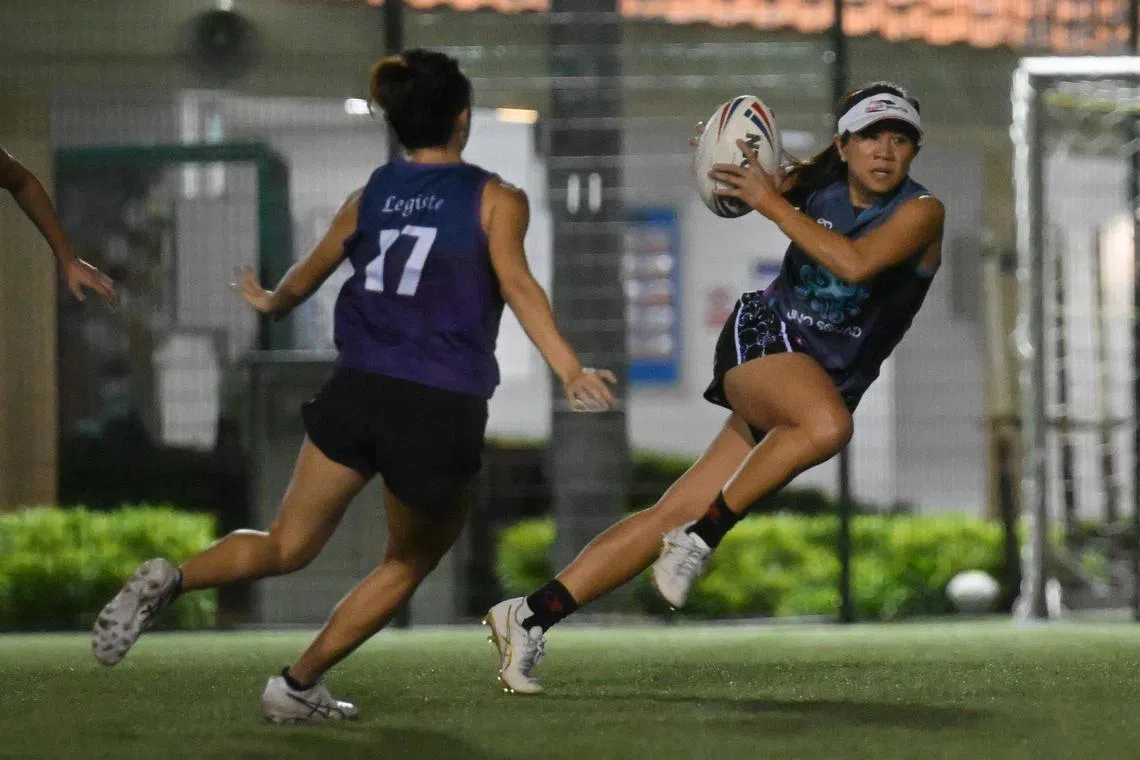ST Sports’ Play of the Month – Touch rugby
In a special series, Play of the Month, The Sunday Times’ sports desk will dive into a sport. Every month this year, an expert in a sport will provide tips on how to play and get better at it. The November spotlight is on touch rugby.
Sign up now: Get ST's newsletters delivered to your inbox

Jeslyn Lim picked up touch in 1997 and has continued to be involved in the sport ever since.
ST PHOTO: SHINTARO TAY
Follow topic:
SINGAPORE – Jeslyn Lim’s start in touch rugby was unexpected. In 1997, she was training to be a teacher at the National Institute of Education when she was introduced to the sport, a variant of rugby league.
A local club was training at the Ministry of Education’s Co-Curricular Activities Branch (CCAB) and a member approached Lim and her friend, asking if they wanted to try out a new sport.
After her first try, Lim was hooked and has not stopped since.
On the appeal of touch, the 49-year-old said: “I like the intensity of the game, I like that it’s fast. Then there’s the camaraderie that you build with your teammates.
“It’s not just a physical game that tests your physical capabilities, but it’s also a mind game because you always have to think about how to beat your opponents.”
Touch started in Australia in the early 1960s as a social or “park” game, and as a training technique for rugby league.
Over the years, the sport has grown internationally and it is played in over 80 countries now.
In touch, the tackling of opposing players seen in contact rugby is replaced by a touch or contact made between a player in possession and a defending player.
It is played over two 20-minute halves between teams of six.
Each side has six touches to score a try, which earns a team one point. After six touches with no score, there is a changeover in possession.
Lim noted that the sport has evolved, with teams fielding seven players each when she first started.
She has taken part in five Touch World Cups since 1999 and won two bronze medals.
The teacher has also represented Singapore in contact rugby and was part of the team who clinched the rugby sevens silver at the 2015 SEA Games on home soil.
Throughout her playing career, Lim has also sought to promote the sport by serving on local governing body Touch Singapore’s executive committee and coaching.
In 2000, she started a touch team for girls in Bedok South Secondary School where she was teaching. She now works and coaches at the International French School.
Also trying to grow the sport is men’s 40s captain Gideon Loh. The physical education teacher started a touch interest group at Broadrick Secondary School a decade ago, coaching a team of students who were enthusiastic about the sport.
Loh first started playing rugby in St Andrew’s Junior School, but his smaller frame eventually prompted him to make the switch to touch in 2004, when he went to Australia to study.
Loh, 43, who has been to three World Cups, said: “I still love the game of rugby, but I enjoy the fact that someone my size is not at a severe disadvantage.
“Another aspect why I love the game is that you can be short or tall, both physiques have their pros and cons.”
He counts representing Singapore at the 2011 World Cup as one of the highlights of his career as it was the first time they fielded a men’s open team.
Several obstacles remain in the sport’s development such as space constraints – especially with the closure of Turf City in December 2023 – and a lack of participation at the primary and secondary school levels.
But Touch Singapore has tried to expand its reach by engaging the community with league competitions that cater to different ages and skill levels.
It also hosts international tournaments that attract teams from across the region, including Australia and Hong Kong, while also running inter-school and tertiary institution games.
At the grassroots level, it focuses on grooming coaches through accreditation courses and workshops, and it has also introduced a high-performance series for national players to share their knowledge with the community.
Touch Singapore’s national coaching director Khairullah Abdul Razak said: “Our mid- to long-term goal is to align our programmes with the Sport Singapore coaching pathway, creating a symbiotic relationship to develop all aspects of the sport.
“This includes a comprehensive approach to player development, as well as coaching and refereeing pathways. By doing so, we ensure that coaches, referees, and players remain relevant and well-prepared in an ever-evolving game.”
The 2024 Touch World Cup in Nottingham featured 13 categories determined by age group and gender: men’s (open, 30, 35, 40, 45, 50, 55), women’s (open, 27, 35, 40) and mixed (open and 30).
Three tips from an expert:
Cardio is key – In an average touch game at international level, players are expected to run six to seven kilometres and usually play two games a day.
Building your core – While it is a safe game, there is still a certain amount of physicality involved so having core and overall strength is important.
Perfecting your passes – Do not be afraid that you will not be able to pick it up immediately. There are many YouTube clips showing how to make a good pass, start practising and find your comfort level.

